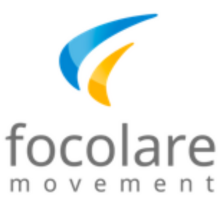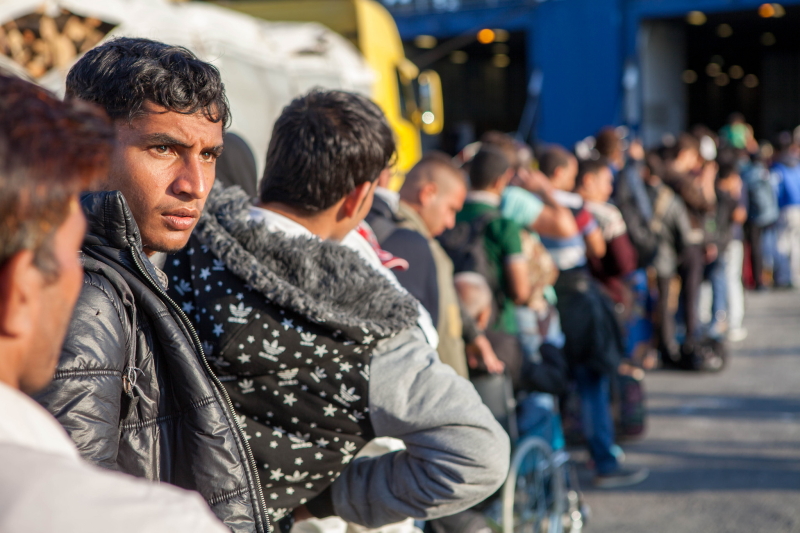

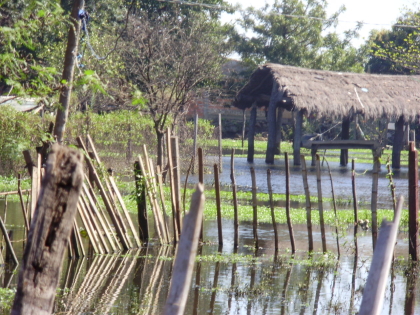
Guaranì Project of the Focolare in Paraguay
 “Scholars estimate that from 3000 BC, populations from the Southeast Asian continent arrived here. Among them were also the Guaranì people, composed of many ethnic groups that through the centuries spread to the Caribbean up to the southernmost tip of the continent,” explained Diana Durán, a Paraguayan sociologist and scholar of the aborigines of America. The meeting with a small community of the Avà Guaranì and Mbya ethnic groups came about two years ago, when a big flood of the Paraguay river forced the indigenous group of 33 families (115 members) to abandon the unsteady settlement on the banks of the river where they used to live by gathering wastes from the dumpsite nearby. “At the start we tried to help them with clothing, food, medicine, and healthcare, like the hospitalisation of a diabetic patient, intervening with one of them who had gunshot wounds, renting mobile toilettes when they were sent away to a desert area, or when, after a storm we collected tents and drinking water… and yet we saw that these actions were still insufficient. They needed a piece of land, that could give them shelter and security.“ After a long search, a suitable lot was found: 5.5 hectares at 4.5 km from the city of Ita, with a school and medical dispensary close by. All was surrounded by greens and above all, with the possibility to cultivate a community orchard for their self-support and the space to build a facility for educational courses. The challenge now is to find the finances to buy the land. “We knocked on many doors – Diana recounts. A qualified person helped us to obtain the juridical status as an Indigenous Community, so they would be entitled ownership of the property. Furthermore, a friend of the Mennonite Community offered to advance the payment of the land, which seemed impossible for us to do. We undertook, with our Avà friends, to pay back the money by instalment.” “God has looked on us with special love», the head of the community, Bernardo Benítez, said. It was a God who they regard as the “First and Foremost God,” whose main command is mutual love. He is present in the daily acts and gave this land, a sacred place to protect and where we can build fraternal relationships. “Standing by the Yary Mirì community also means suffering – Dian affirmed – due to the discrimination they suffer because of ancestral prejudices, and the misery they live in. But it is a joy to acknowledge and share the community and solidarity values they have conserved through the centuries, besides the love and trust that has been established between us and them. Today we are not alone but have the support of many friends, two associations linked to the Focolare (Unipar and Yvy Porà) that support the development of the community orchard), two bishops, some officers from financial institutions, two Mennonite Christians and the Indigeneous Pastoral. We obtained four scholarships in Educational Sciences for their leader and three youths. They themselves chose that faculty ‘because our people need education,’ they said.” “I am now writing a book on the history of their community – Diana Durán concluded – not only as a denunciation and to give a voice to those who have no say, but as an obligation to them for what they have suffered and what we owe to them. I consider it a step towards universal brotherhood, our Ideal.”
“Scholars estimate that from 3000 BC, populations from the Southeast Asian continent arrived here. Among them were also the Guaranì people, composed of many ethnic groups that through the centuries spread to the Caribbean up to the southernmost tip of the continent,” explained Diana Durán, a Paraguayan sociologist and scholar of the aborigines of America. The meeting with a small community of the Avà Guaranì and Mbya ethnic groups came about two years ago, when a big flood of the Paraguay river forced the indigenous group of 33 families (115 members) to abandon the unsteady settlement on the banks of the river where they used to live by gathering wastes from the dumpsite nearby. “At the start we tried to help them with clothing, food, medicine, and healthcare, like the hospitalisation of a diabetic patient, intervening with one of them who had gunshot wounds, renting mobile toilettes when they were sent away to a desert area, or when, after a storm we collected tents and drinking water… and yet we saw that these actions were still insufficient. They needed a piece of land, that could give them shelter and security.“ After a long search, a suitable lot was found: 5.5 hectares at 4.5 km from the city of Ita, with a school and medical dispensary close by. All was surrounded by greens and above all, with the possibility to cultivate a community orchard for their self-support and the space to build a facility for educational courses. The challenge now is to find the finances to buy the land. “We knocked on many doors – Diana recounts. A qualified person helped us to obtain the juridical status as an Indigenous Community, so they would be entitled ownership of the property. Furthermore, a friend of the Mennonite Community offered to advance the payment of the land, which seemed impossible for us to do. We undertook, with our Avà friends, to pay back the money by instalment.” “God has looked on us with special love», the head of the community, Bernardo Benítez, said. It was a God who they regard as the “First and Foremost God,” whose main command is mutual love. He is present in the daily acts and gave this land, a sacred place to protect and where we can build fraternal relationships. “Standing by the Yary Mirì community also means suffering – Dian affirmed – due to the discrimination they suffer because of ancestral prejudices, and the misery they live in. But it is a joy to acknowledge and share the community and solidarity values they have conserved through the centuries, besides the love and trust that has been established between us and them. Today we are not alone but have the support of many friends, two associations linked to the Focolare (Unipar and Yvy Porà) that support the development of the community orchard), two bishops, some officers from financial institutions, two Mennonite Christians and the Indigeneous Pastoral. We obtained four scholarships in Educational Sciences for their leader and three youths. They themselves chose that faculty ‘because our people need education,’ they said.” “I am now writing a book on the history of their community – Diana Durán concluded – not only as a denunciation and to give a voice to those who have no say, but as an obligation to them for what they have suffered and what we owe to them. I consider it a step towards universal brotherhood, our Ideal.”
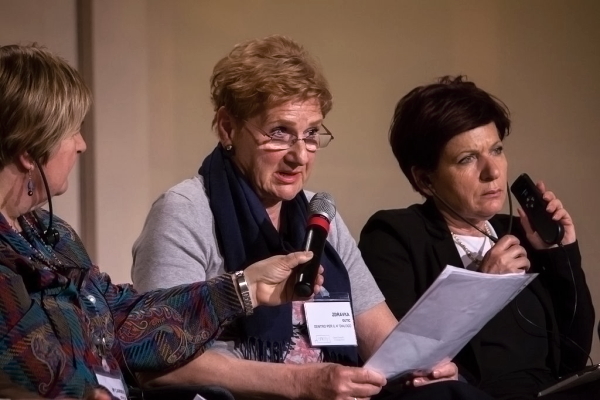
Stories from Bosnia
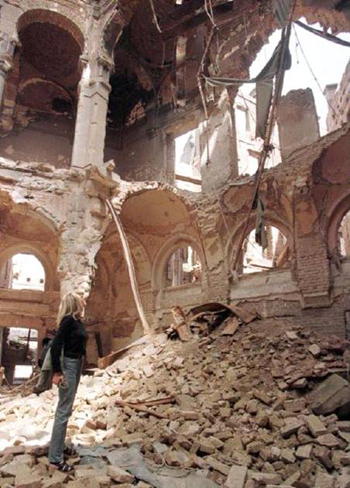 “I come from Sarajevo, Bosnia and Erzegovina, where for centuries, Bosnian Muslims, Croatian Catholics, Orthodox Serbs, Jews, Romani ethnic groups and others have lived alongside one another. The war of the 1990s that wanted to convince us that it is impossible to live together, only wrought thousands of victims, a million refugees, and devastation of cities, religious buildings and historical monuments. In our condominium there were Croatians, Serbs, and Bosnian Muslims, but we shared everything we had with one another, up to the last cigarette, the little oil, flour, coffee and also the pain of death. My husband who was working as an amateur radio technician in the State institutions, had installed a radio station to connect the people who, for months, due to the interruption of telephone lines, knew nothing about their loved ones. When the conflict ended, I started to get involved in politics, in the Social Democratic Party and became a candidate for the post of municipal councilor. The consequences of the war were terrible. In that period, a mayor from Sarayevo received an invitation to participate in the meeting “Together for Europe” in Stuttgart, and delegated me since he couldn’t go. It was then that I was introduced to the Focolare Movement, the people who live to bring unity to humanity. You may well imagine what this meant for me, coming from a war experience. On returning home I felt a great urge to live and fight to diffuse the ideals I had just met. Now, after 20 years, in our city we are still mourning our dead, and rebuilding what was destroyed, but we are also building bridges between people. We do this together, without hatred. And precisely in these days Sarajevo is celebrating the 20th anniversary of the end of the siege of the city, which lasted 1,425 days during which 12,000 civilians were killed, out of which 1,500 were children. The city’s wounds have now healed and it has regained its long lost spirit. The bells ring and prayer arising from the minarets of the mosques echo in the squares. Since I am an agnostic, I found myself involved in the dialogue started by Chiara Lubich with people who have no religious beliefs. I try to weave this network of communion and mutual comprehension in my city, with the Muslim cities nearby, and with the Catholics – for example, during the visit of Pope Francis, and with the people of various beliefs. Today in Sarajevo there is a group of young people, also of different faiths and cultures, who are also trying to diffuse the culture of dialogue.
“I come from Sarajevo, Bosnia and Erzegovina, where for centuries, Bosnian Muslims, Croatian Catholics, Orthodox Serbs, Jews, Romani ethnic groups and others have lived alongside one another. The war of the 1990s that wanted to convince us that it is impossible to live together, only wrought thousands of victims, a million refugees, and devastation of cities, religious buildings and historical monuments. In our condominium there were Croatians, Serbs, and Bosnian Muslims, but we shared everything we had with one another, up to the last cigarette, the little oil, flour, coffee and also the pain of death. My husband who was working as an amateur radio technician in the State institutions, had installed a radio station to connect the people who, for months, due to the interruption of telephone lines, knew nothing about their loved ones. When the conflict ended, I started to get involved in politics, in the Social Democratic Party and became a candidate for the post of municipal councilor. The consequences of the war were terrible. In that period, a mayor from Sarayevo received an invitation to participate in the meeting “Together for Europe” in Stuttgart, and delegated me since he couldn’t go. It was then that I was introduced to the Focolare Movement, the people who live to bring unity to humanity. You may well imagine what this meant for me, coming from a war experience. On returning home I felt a great urge to live and fight to diffuse the ideals I had just met. Now, after 20 years, in our city we are still mourning our dead, and rebuilding what was destroyed, but we are also building bridges between people. We do this together, without hatred. And precisely in these days Sarajevo is celebrating the 20th anniversary of the end of the siege of the city, which lasted 1,425 days during which 12,000 civilians were killed, out of which 1,500 were children. The city’s wounds have now healed and it has regained its long lost spirit. The bells ring and prayer arising from the minarets of the mosques echo in the squares. Since I am an agnostic, I found myself involved in the dialogue started by Chiara Lubich with people who have no religious beliefs. I try to weave this network of communion and mutual comprehension in my city, with the Muslim cities nearby, and with the Catholics – for example, during the visit of Pope Francis, and with the people of various beliefs. Today in Sarajevo there is a group of young people, also of different faiths and cultures, who are also trying to diffuse the culture of dialogue.
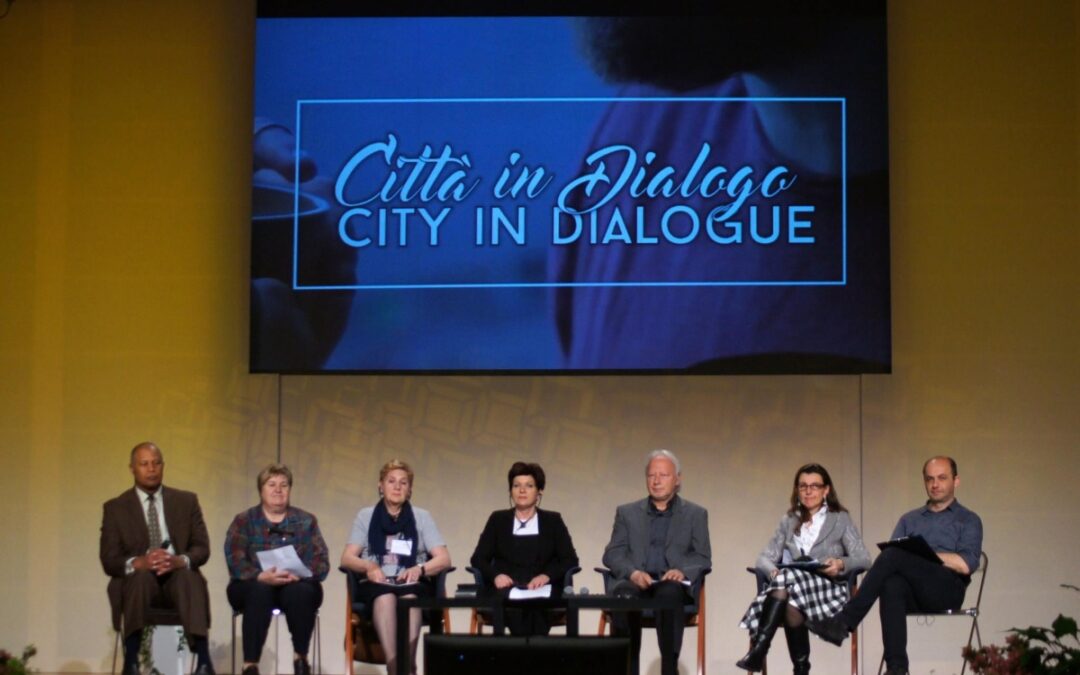
City in Dialogue: Networks of light to inhabit the planet
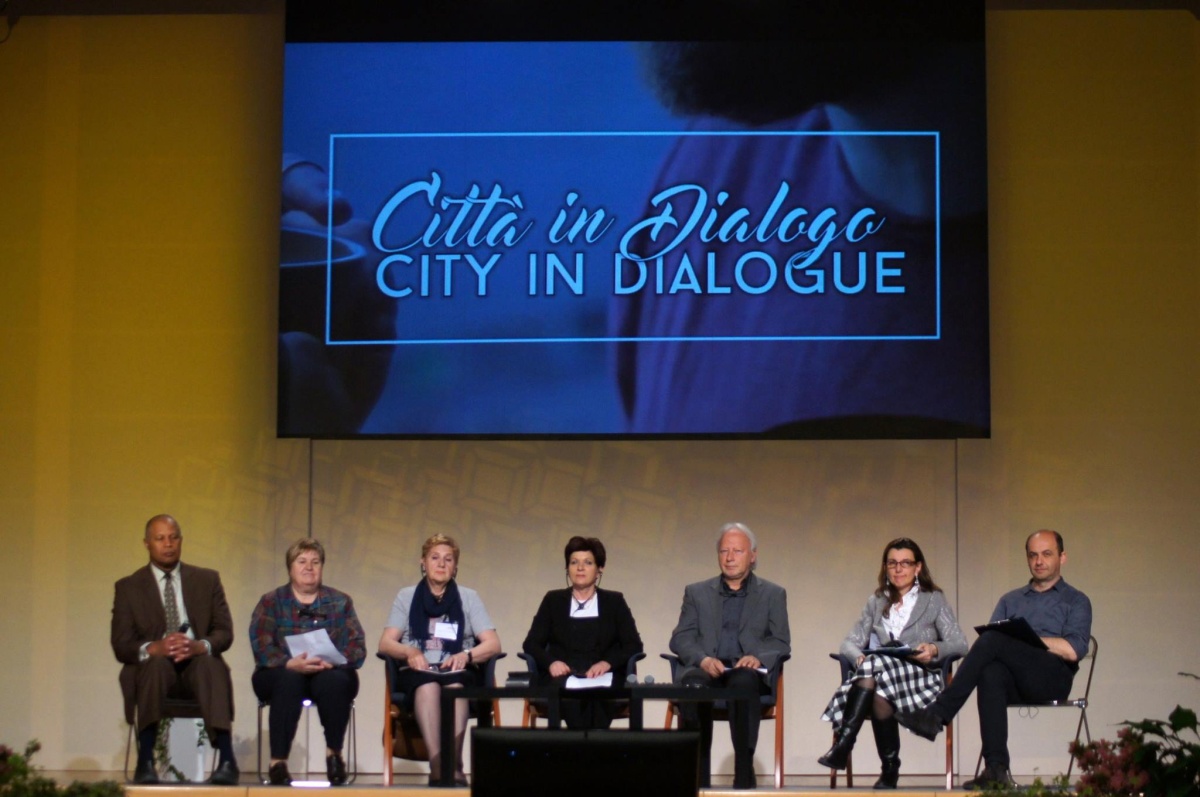 The line is long and quite boring. People of all ages from many parts of the world are patiently waiting for lunch as they share their thoughts and opinions about the morning. The first session of the OnCity – Networks of lights to inhabit the planet Conference has just concluded. The conference took place on April 1-3, 2016 and really showed the many lights that have been lit up in our cities. “Rather than dwelling on an analysis of the darkness,” says Lucia Fronza Crepaz who is the moderator, “we’ve decided to turn our attention to the dawn, to the rising sun.” OnCity is organised by the New Humanity Movement, Youth For a United World, and the United World Project which are Focolare agencies actively engaged in building a more united and fraternal world at the social level, amongst young and old and through support and development projects. Certainly the current news stories constantly cry out to us : bombings, terrorism, new forms of marginalisation and poverty, piecemeal wars. Our cities are experiencing problems and contradictions in front of our very eyes. But there are also very positive and well-established experiences which confirm that it is possible to work, to hope, to believe in a more supportive and fraternal city that would be more liveable for everyone. With this awareness the organisers set out to create a three-day event in which the nearly 900 participants would be given the opportunity to experience a new kind of city life with one another, that could be taken back to their home environments. It was an opportunity to examine the topics of solidarity and fraternity in order to be be able to interpret the changes we see taking place in the cities where we live, and to learn a lifestyle based on dialogue. OnCity played out in three plenary sessions, thematic seminars and a good 32 work groups which were useful for coming to an understanding of their ability to be active, creative and responsible citizens. Forty six presentations were squeezed into those days with the purpose of valuing and appreciating the networks that already exist and encouraging new ones where needed: starting up “cells of brotherhood” wherever we are. Source: Città Nuova online
The line is long and quite boring. People of all ages from many parts of the world are patiently waiting for lunch as they share their thoughts and opinions about the morning. The first session of the OnCity – Networks of lights to inhabit the planet Conference has just concluded. The conference took place on April 1-3, 2016 and really showed the many lights that have been lit up in our cities. “Rather than dwelling on an analysis of the darkness,” says Lucia Fronza Crepaz who is the moderator, “we’ve decided to turn our attention to the dawn, to the rising sun.” OnCity is organised by the New Humanity Movement, Youth For a United World, and the United World Project which are Focolare agencies actively engaged in building a more united and fraternal world at the social level, amongst young and old and through support and development projects. Certainly the current news stories constantly cry out to us : bombings, terrorism, new forms of marginalisation and poverty, piecemeal wars. Our cities are experiencing problems and contradictions in front of our very eyes. But there are also very positive and well-established experiences which confirm that it is possible to work, to hope, to believe in a more supportive and fraternal city that would be more liveable for everyone. With this awareness the organisers set out to create a three-day event in which the nearly 900 participants would be given the opportunity to experience a new kind of city life with one another, that could be taken back to their home environments. It was an opportunity to examine the topics of solidarity and fraternity in order to be be able to interpret the changes we see taking place in the cities where we live, and to learn a lifestyle based on dialogue. OnCity played out in three plenary sessions, thematic seminars and a good 32 work groups which were useful for coming to an understanding of their ability to be active, creative and responsible citizens. Forty six presentations were squeezed into those days with the purpose of valuing and appreciating the networks that already exist and encouraging new ones where needed: starting up “cells of brotherhood” wherever we are. Source: Città Nuova online

Philippines: Interfaith Harmony Week
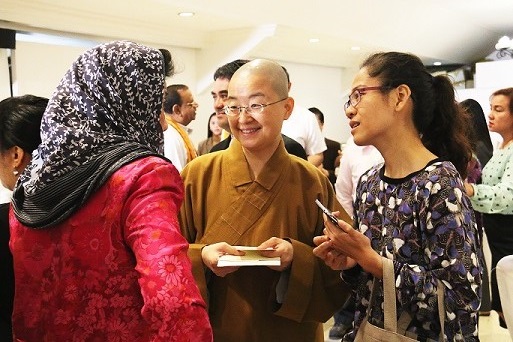
Breakfast Dialogue with Cardinal Tagle opens 2016 World Interfaith Harmony Week. Photo: Roman Catholic Archdiocese of Manila
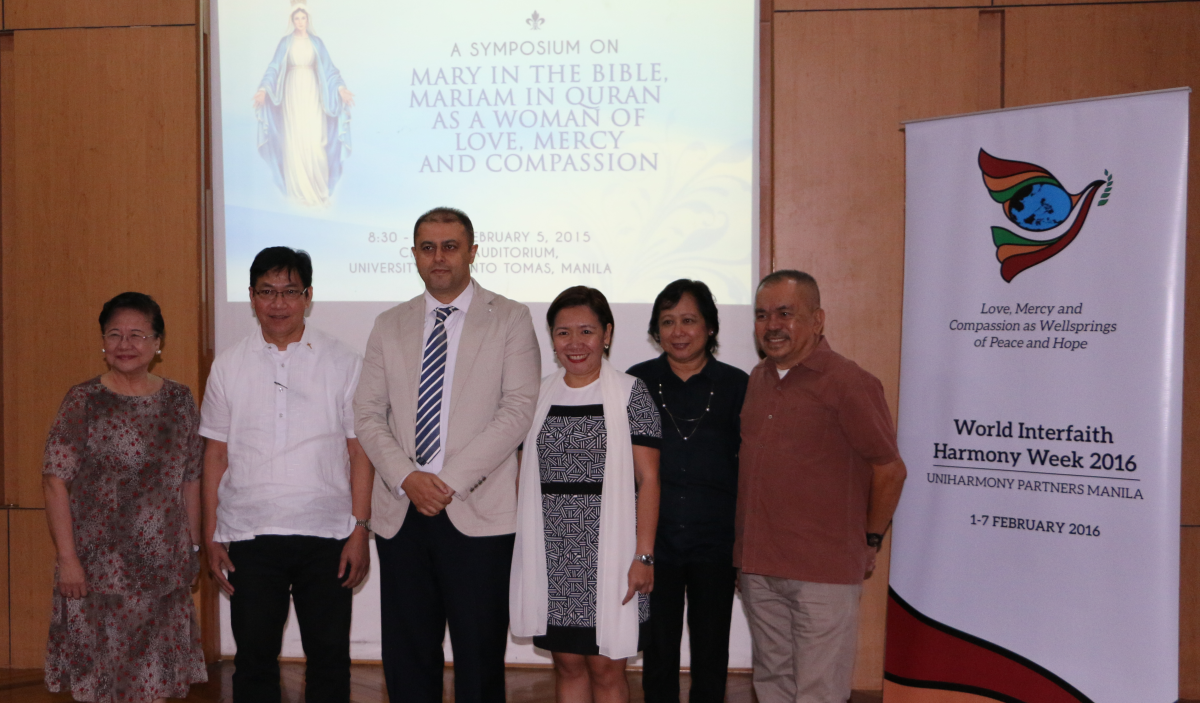 A joint symposium on Mary in the Bible and Mariam in Quran also proved to be quite interesting. The unanimous conclusion: Mary, woman of love, mercy and compassion, is a mother for all Christians and Muslims. Another significant event saw the attendance of 80 cancer patients and survivors. The opening remarks were based on the spirituality of Chiara Lubich. At the Fo Guang Shan Mabuhay Buddhist Temple the awards ceremony of a digital poster-making contest took place. It was organized with the Buddhist International Association – Manila, on the theme “Creating Peace and Hope through Acts of Goodness”. An activity was also organized in Quezon City, Metro Manila, where, for some years now, Sulyap ng Pag-asa (Glimpse of Hope) is found. It is a housing project of the Focolare undertaken for the purpose of providing housing to homeless families. Here some 90 Christian and Muslim children spent an exciting afternoon together, with songs, dances and games which helped them understand how to build fraternity despite differences in culture and religion. The culminating activity of the week-long celebration was the Festival of Harmony held in a big shopping mall in Mandaluyong, Metro Manila. It attracted an extraordinary participation indeed. Cardinal Tagle and the participants in the breakfast dialogue were joined by other institutional dignitaries, by people who had participated in the various events during the week, by ordinary people. After highlighting mutual cooperation between the government and the religious sectors in promoting religious freedom, dialogue and peace, the program continued with musical numbers from the youth and children of various faith groups. A young member of the Focolare introduced a choreography and said: “To attain love, mercy and compassion as wellsprings of peace, there is the need to overcome diversities, … and to be united for peace and harmony.” With other children of different religions, a girl was chosen to speak in the name of the Roman Catholic Church. She said: “To me, peace is harmony and love. When God created the world, everything was fine. There was balance and harmony with the plants and animals. When man came, it was okay for a while until he became greedy. He cut down trees, flattened mountains and now cement is everywhere! Animals became extinct. There is no more balance and harmony. I dream of harmony in nature. I dream of no war.” Cardinal Tagle’s concluding remarks were an emotional one. Clearly touched and grateful to the children who spoke, he cited all the various talks making the different subjects his own.
A joint symposium on Mary in the Bible and Mariam in Quran also proved to be quite interesting. The unanimous conclusion: Mary, woman of love, mercy and compassion, is a mother for all Christians and Muslims. Another significant event saw the attendance of 80 cancer patients and survivors. The opening remarks were based on the spirituality of Chiara Lubich. At the Fo Guang Shan Mabuhay Buddhist Temple the awards ceremony of a digital poster-making contest took place. It was organized with the Buddhist International Association – Manila, on the theme “Creating Peace and Hope through Acts of Goodness”. An activity was also organized in Quezon City, Metro Manila, where, for some years now, Sulyap ng Pag-asa (Glimpse of Hope) is found. It is a housing project of the Focolare undertaken for the purpose of providing housing to homeless families. Here some 90 Christian and Muslim children spent an exciting afternoon together, with songs, dances and games which helped them understand how to build fraternity despite differences in culture and religion. The culminating activity of the week-long celebration was the Festival of Harmony held in a big shopping mall in Mandaluyong, Metro Manila. It attracted an extraordinary participation indeed. Cardinal Tagle and the participants in the breakfast dialogue were joined by other institutional dignitaries, by people who had participated in the various events during the week, by ordinary people. After highlighting mutual cooperation between the government and the religious sectors in promoting religious freedom, dialogue and peace, the program continued with musical numbers from the youth and children of various faith groups. A young member of the Focolare introduced a choreography and said: “To attain love, mercy and compassion as wellsprings of peace, there is the need to overcome diversities, … and to be united for peace and harmony.” With other children of different religions, a girl was chosen to speak in the name of the Roman Catholic Church. She said: “To me, peace is harmony and love. When God created the world, everything was fine. There was balance and harmony with the plants and animals. When man came, it was okay for a while until he became greedy. He cut down trees, flattened mountains and now cement is everywhere! Animals became extinct. There is no more balance and harmony. I dream of harmony in nature. I dream of no war.” Cardinal Tagle’s concluding remarks were an emotional one. Clearly touched and grateful to the children who spoke, he cited all the various talks making the different subjects his own.
https://www.youtube.com/watch?v=teamVMfAoKw
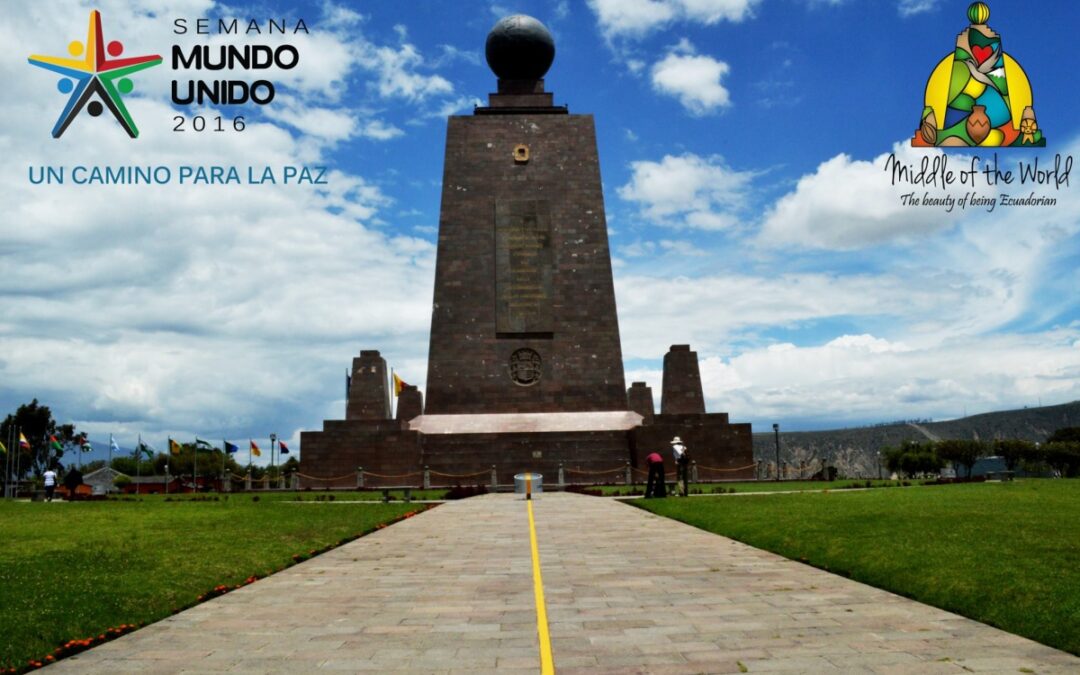
In Ecuador, a festival of peace in the middle of the world
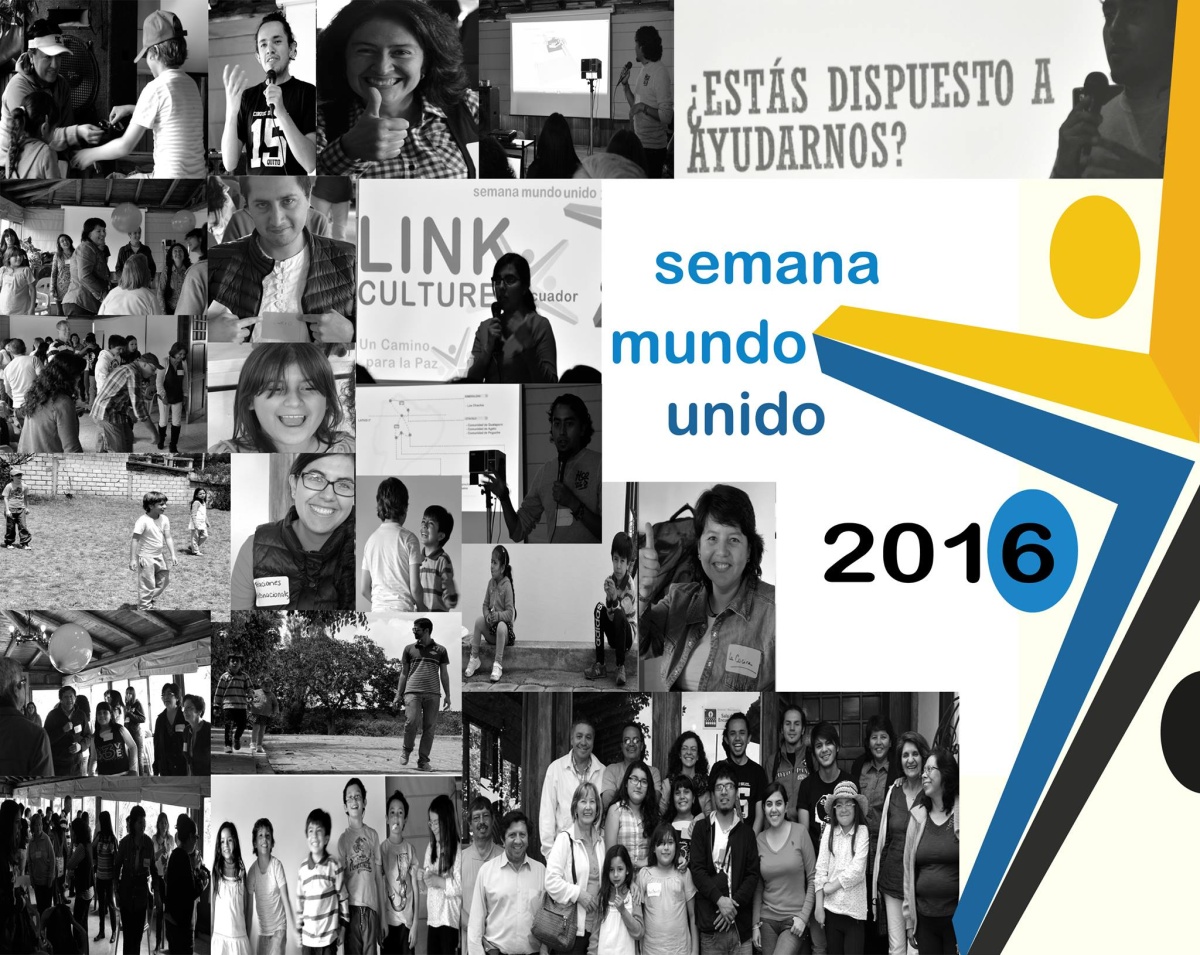 The centre of the 2016 United World Week will be Ecuador where interculturalism, peace and unity in diversity will be celebrated. Events will include opportunities to know and be enriched by the diversity of ethnic cultures in the country. The title of the event is: “LINK CULTURES – Un Camino para la Paz (A Path For Peace), and the overriding theme will be interculturalism that translates into dialogue with different ethnic cultures and recognises their dignity which makes us equals. The event will involve young people from many South American and European countries. Ecuador is strategically situated in the middle of the world. It has a population of some 15 million people and is divided into four main regions: the coastal lowlands, La Sierra, the East and the Galapagos Islands. The country is internationally known for the huge biodiversity, as well as for the multiculturalism of the population. Since 2008 the Ecuadoran Constitution has included interculturalism and multi-nationality and the defence of these characteristic features of the country, as well as the defence and promotion of “Sumak kawsay” (in the indigenous kichwa language, ‘good living’ in harmony with nature) and the rights of nature. UWW 2016 will have two parts. It will begin with a “traveling school” (May 1 – May 6) during which young people will visit several regions of Ecuador to have a living experience of interculturalism in the midst of different communities of the country. They will live and work amongst the local people, becoming more deeply acquainted with life in the South American land. The young people will choose between: Costa-La Sierra and Oriente-La Sierra. The former includes the provinces of Esmeraldas and Imbabura where the young people will have direct contact with the Gualapuro, Agato and Peguche communities. The latter includes the provinces of Pastaza, Tungurahua and Bolicar where they will meet the Shiwacocha, Kisapincha, Salasaka and Bolivar communities. Each stop is meant to be an opportunity to build relationships at different levels: with nature, with others and with themselves. Thus, the young people and the local people will be protagonists of real, true laboratories of community living in which they will be able to share, to learn, to experience and to become living witnesses to an exchange of gifts amongst different cultures.
The centre of the 2016 United World Week will be Ecuador where interculturalism, peace and unity in diversity will be celebrated. Events will include opportunities to know and be enriched by the diversity of ethnic cultures in the country. The title of the event is: “LINK CULTURES – Un Camino para la Paz (A Path For Peace), and the overriding theme will be interculturalism that translates into dialogue with different ethnic cultures and recognises their dignity which makes us equals. The event will involve young people from many South American and European countries. Ecuador is strategically situated in the middle of the world. It has a population of some 15 million people and is divided into four main regions: the coastal lowlands, La Sierra, the East and the Galapagos Islands. The country is internationally known for the huge biodiversity, as well as for the multiculturalism of the population. Since 2008 the Ecuadoran Constitution has included interculturalism and multi-nationality and the defence of these characteristic features of the country, as well as the defence and promotion of “Sumak kawsay” (in the indigenous kichwa language, ‘good living’ in harmony with nature) and the rights of nature. UWW 2016 will have two parts. It will begin with a “traveling school” (May 1 – May 6) during which young people will visit several regions of Ecuador to have a living experience of interculturalism in the midst of different communities of the country. They will live and work amongst the local people, becoming more deeply acquainted with life in the South American land. The young people will choose between: Costa-La Sierra and Oriente-La Sierra. The former includes the provinces of Esmeraldas and Imbabura where the young people will have direct contact with the Gualapuro, Agato and Peguche communities. The latter includes the provinces of Pastaza, Tungurahua and Bolicar where they will meet the Shiwacocha, Kisapincha, Salasaka and Bolivar communities. Each stop is meant to be an opportunity to build relationships at different levels: with nature, with others and with themselves. Thus, the young people and the local people will be protagonists of real, true laboratories of community living in which they will be able to share, to learn, to experience and to become living witnesses to an exchange of gifts amongst different cultures. 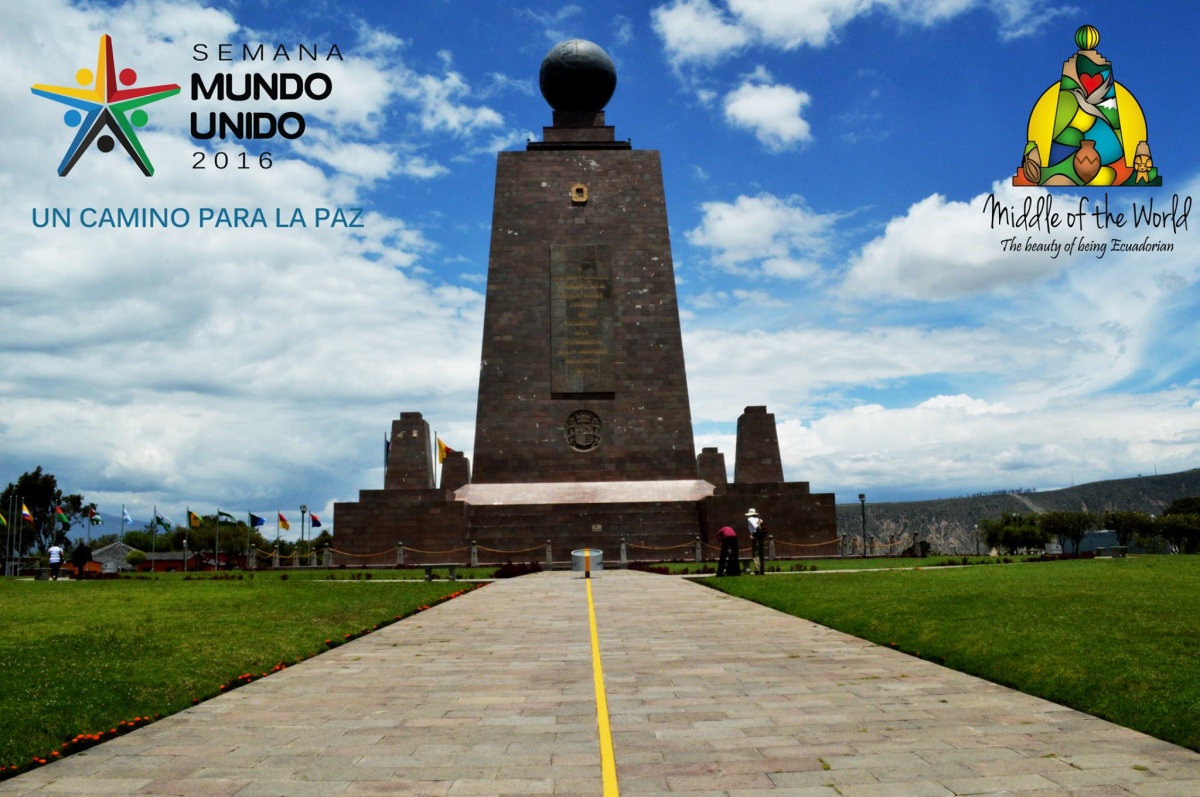 The second part (May 7) will be a Festival For Peace in the tourist region known as The Middle of the World, an Ecuadoran icon that is internationally famous. It will be a large event that will engage young people from many cultures, faiths and walks of life. The goal is to highlight fraternity in an intercultural context and to commit to living peace and unity in respect for differences, through the practice of the Golden Rule that invites us to “Do to others as you would have them do to you.” The Young For Unity in Ecuador is also promoting two contests, one for music and another for photography. They have high dreams of beginning a permanent Peace School. Simultaneous events will take place in other cities of the world during United World Week 2016, which will be led by the young peacemakers. Information: info@mundounido2016.com Official website: www.mundounido2016.com
The second part (May 7) will be a Festival For Peace in the tourist region known as The Middle of the World, an Ecuadoran icon that is internationally famous. It will be a large event that will engage young people from many cultures, faiths and walks of life. The goal is to highlight fraternity in an intercultural context and to commit to living peace and unity in respect for differences, through the practice of the Golden Rule that invites us to “Do to others as you would have them do to you.” The Young For Unity in Ecuador is also promoting two contests, one for music and another for photography. They have high dreams of beginning a permanent Peace School. Simultaneous events will take place in other cities of the world during United World Week 2016, which will be led by the young peacemakers. Information: info@mundounido2016.com Official website: www.mundounido2016.com
